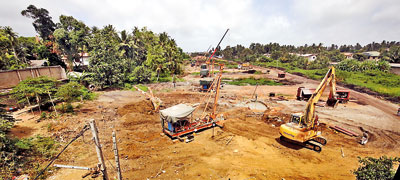News
Undervalued, say owners of lands under acquisition

The authorities are trying hard to educate people about the purposes for which their lands are being taken. Pix by M.A. Pushpa Kumara
Sri Lanka is once again in the throes of a massive land acquisition drive. Hundreds of thousands of acres of private properties are being taken over by the Government for development projects and officials are grappling with the fallout.
Sixty-five-year-old H. A. Hemawathie insists that her land, which is being taken over for the Outer Circular Highway, has been undervalued. She stood stoically outside her house in Mattumagala near the Colombo-Negombo road. Along with a few others, she is refusing to leave in the conviction that the State has been unfair.
Just metres from her home, Chinese and Sri Lankan workers were busy with construction. The Road Development Authority aims for the project to be completed by June 30, 2019. This stretch will connect the highway from Kadawatha to Kerawalapitiya as well as link up the Colombo-Katunayake with the new Central and the Southern Expressways.
For now, the authorities have left Mrs Hemawathie’s house and those of the others untouched. Three families reside with her. One of her daughters is a widow with a child. Relocating would make life impossible for them if fair compensation was not paid.
This is only the tip of the iceberg. The Department of Government Printing website shows that 80 land acquisition gazettes were issued in August alone. Each pertains to hundreds of plots, big and small. Up to Friday, 41 other gazettes had been issued (just in September) to cover acquisitions. Acquisition notices were the largest group of gazettes the Department has printed over the past several months, an official confirmed.
The Government is empowered under the Land Acquisition Act to secure any private land provided it is for public purpose. Lands Ministry statistics point to a significant spike in ‘Section 2 Notices’. Issued by Divisional Secretaries, they contain details of lands the Government has earmarked for takeover. Last year, a total of 267 were published. This year, there are already 328. Each includes anywhere between several dozen to over 100 plots.
The Treasury allocation for land acquisitions rose from Rs 2.1 billion last year to over Rs 2.3 billion in 2016. This month, the Highways Ministry sought an additional Rs 2.79 billion to meet acquisition and other costs arising from building the elevated highway from New Kelani Bridge to Athurugiriya; Port Access elevated highway; and Marine Drive extension to Panadura. It also requested Rs. 1 billion to pay compensation for acquisition under the Kandy City Development Project.
Other development projects will cause still more displacements. Chief among these are the Western Region Megapolis initiative, the Central Expressway, the Southern Expressway extension and several village expansion projects. The worst is yet to come.
The authorities are trying hard to educate people about the purposes for which their lands are being taken, said I. H. K.Mahanama, Secretary to the Lands Ministry. He insists that the key players–Highways Ministry, Urban Development Authority and RDA–are taking precautions to minimse tthe negative impacts on people who are forced to relinquish lands. And people were aware they had to make sacrifices for development.
But social issues arising from uprooting them, sometimes along with entire communities, were still not adequately addressed, he accepted. “At the end of the day, you have to start life from the beginning,” he said. “People are familiar with those surroundings, that society. They are familiar with their neighbours. They are losing everything. Whatever the amount you give cannot compensate for that.”
Desperate people flock to his office, sometimes to his home, to air their grievances. They range from the loss of livelihoods to problems in finding new schools for children. In reality, these social challenges were unavoidable. “However, I would say we have so far not developed a mechanism to effectively address them,” Dr Mahanama reiterated.
Acquisitions are drawn-out processes. It could take years from when the Government first makes its intention clear to when a particular plot is taken over. The procedure is designed so that respective landowners could sufficiently inform themselves, said G.A.K.M.A. Kariyappar, Assistant Director at National Involuntary Resettlement Project (NIRP) of the Lands Ministry.

H. A. Hemawathie
Land Acquisition and Re-settlement Committees (LARCs) handle compensation for landowners affected by road construction. These are set up in respective Divisional Secretariats. Those unhappy with the payouts determined by LARCs can appeal to the Super LARCs at the Road Development Authority (RDA).
The worth of a plot of land is decided by the Valuation Department. One of the main problems facing officials, however, is a mismatch between reality and expectation where compensation is concerned. A lack of transparency in land acquisition in the past has also complicated matters, said an authoritative Government source. There have been times when Governments took over private lands on political motives. This meant that even bona fide projects were now viewed with suspicion.
Many of those the Sunday Times interviewed wanted anonymity on the basis that their appeals regarding compensation and related matters were still pending. They feared that speaking openly might upset the officials they were dealing with.
Compensation wasn’t their only concern. Many have lived in their respective areas for decades, sometimes generations. Land prices were steadily rising. If they received a small compensation package, it would made it impossible for them to buy any property nearby.
“The noise from the construction is unbearable,” said one resident. Work went on during the night. “The nights actually are the worst,” she admitted, saying they couldn’t sleep and the house shook.
One old couple whose house is listed for demolition lamented that the uncertainty has taken a heavy emotional toll on them. “We used to grow fruits and vegetables,” one said. “That is no longer possible. We can’t spend much money on repairs to the house since we know it’ll be demolished once it is with the Government. Our children and grandchildren have left the place. We also have children of marriageable age but don’t even have a house or land to give as dowry. Every sense of a normal life is gone.”
Those who are holding out do agree that the country needs development projects. But they had reservations about the process of land acquisition, particularly compensation. And it doesn’t apply to just this one project.
More than 50 percent of marked lands in the Kadawatha-Mirigama stretch of the Central Expressway are now in Government hands, said B.D.S. Kumara, the relevant Project Director. “The thorniest issue is compensation,” he observed. Most people place a far higher value on their lands and properties than what valuation officials cite. This leads to disputes which officials say they try their best to resolve through LARCs and Super LARCs.
The issues extend beyond recompense for houses, buildings or gardens. Farmers in Mirigama are protesting for more money over loss of agricultural lands being acquired for the Central Expressway. The matter remains unresolved.
Back in Mattumagala, the community is dealing with yet another consequence of the Government’s acquisition drive. There are divisions among them based on what they perceive others are tipped to receive as compensation.
“In the beginning, most of us were in this together,” one woman said. They had even formed a society. As the years lapsed, however, more and more people left. The feeling of togetherness has been replaced by jealousy and mistrust. The sense of community has died.

